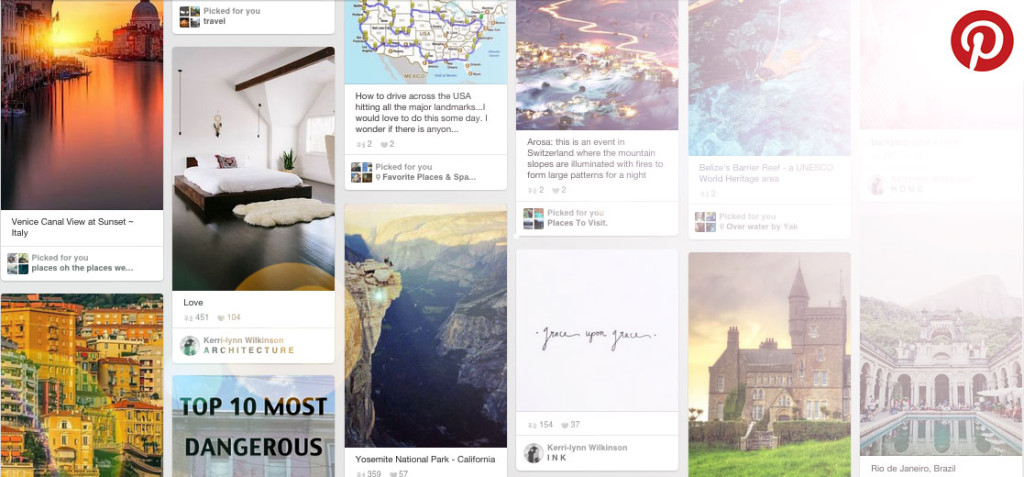Ahhh, Pinterest – the online pinboard and every woman’s favorite addiction. Since this social networking site caught fire, Pinterest has been fondly nicknamed everything from digital crack to pure virtual estrogen.
The website allows users (80% of whom are women) to share and save photos that they enjoy to “pin boards” of a certain type; for example, pinning the newly refreshed scrunchie trend to a My Style board or a fabulously easy crockpot recipe to a Slow Cooker board. It’s the “photo scrapbook of hopes, dreams, and desires for grown-ups.” Photos are sourced from all over the web or from users themselves, most linking to referenced articles and other locations. The most pinned categories include Food & Drink, DIY & Crafts, Home Decor, and Holidays & Events. Most web browsers even offer the “Pin It” button that you can embed into your navigation bar for easy access from any online page.
Pinterest operates somewhat like Tumblr, with a long scrolling interface that features a mix of pins from the other users whose pinboards you personally follow and a few promoted or suggested pins. The point is content curation; to develop a personal collection of what you love and want to save for future reference or inspiration. Many companies use Pinterest as a way to gain exposure. Here’s how Ryan Pinkham at Constant Contact describes the pinning process:
1. You’re a bakery and you pin a picture of a fresh batch of muffins.
2. My friend, who’s already a customer and follows your “Muffins” board, sees the picture LOVES IT! and repins it to her “Muffin Madness” board.
3. I, a lover of muffins, but not currently a customer of yours, see the picture…LOVE IT…repin it to my “MMMuffin” board and click on your name to find out who you are…
This week, Pinterest announced that they will soon be launching “buyable pins.” Similar to other social networks, Pinterest is trying to close the gap between discovery and purchase intent and prove to brands that users will convert. Eliminating redirects and clicks is a good way to start.
Why is it called Pinterest?
With the vast hoard of women that use and evangelize Pinterest, you might be surprised to discover that in 2010 it was actually co-founded by three men, Evan Sharp, Paul Sciarra, and Ben Silbermann. The company has raised over 500 million dollars, has over 72 million active users and was recently valued at over 15 billion dollars, making them one of the most interesting privately held tech brands. The idea appears to have been birthed organically, but was based on the gradual development of visual bookmarking across the internet. The name was first suggested by Silbermann’s now-wife, while she was watching TV. The word is a combination of two concepts, “pinboard” or “pin” and “interest.” Have you ever noticed the subtle pin in their logo?
According to a past Forbes article, just three months after launching the site had already registered 3,000 accounts. After a short languishing period, Pinterest caught fire, mostly thanks to a unique demographic of women in mid-western states like Iowa and Illinois. The company really got off the ground when it introduced its very personal campaign early on called “Pin It Forward.” At the time, Pinterest was invite only, so Pin It Forward allowed people to create pinboards and receive invites by getting other friends to also create pinboards. This helped to fulfill a serious early need for content; Pinterest just doesn’t work unless there are pins to pin. Who creates these pins? The pinners who find pin-able content and flood their personal feeds with inspiration. “We didn’t have an engineering problem,” said Silbermann, “we had a design and community problem.” Lucky for Pinterest, the site grew exponentially. Each new user brought with them a host of new pinners with their own individual taste and influence.
SEE ALSO: Why is it called Instagram?
The Other Side of the Coin
As with just about any fad or trend, there is always a different side to the story. Amongst all the beauty and inspiration and creativity, there has been criticism. Some people worry that Pinterest forces users to lose their own personal inspiration as they are over-saturated with outside influences. Others find it too addicting. Still, others consider it to be the source of some specific types of depression that come from comparing oneself to a highly aspirational, fabricated ideal. Similar to the “fear of missing out” that many people experience when confronted with the fake, perfected lives of people on Facebook and Instagram, Pinterest does have a tendency to create a bubble of unattainable beauty and whimsy. “Pinterest boards advertise only your hopes and dreams…the Stilton Gold style you aspire to, rather than the Velveeta life you live.” said columnist Petula Dvorak in The Washington Post a few years ago in 2012, “It’s exceptionally sticky.”
Still, let’s not forget the beauty. “I see [Pinterest] as a super inspiring place,” says Alison on her blog Deuce Cities Henhouse. “I have only been pinning spaces that truly inspire and trigger a gut reaction in me…it’s actually made me see my style in a more clear and defined way.”
What has been your experience with Pinterest? Do you find it refreshing or challenging? Unattainable or inspiring? Let us know in the comments! Thanks for reading Why is Pinterest Called Pinterest?! #WhyisPinterestcalledPinterest
Lauren Cosgrove is a freelance writer passionate about branding, global issues, and the world’s little mysteries. A Pacific Northwest native, Lauren can be found hiking the great outdoors, practicing her dance steps, or illustrating children’s books.







[…] take off so well; was it the charm of the products themselves? The team Shafer employs? Her use of Pinterest to link items all over the web? Either way, ThreeBirdNest is making a […]